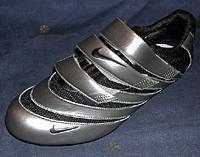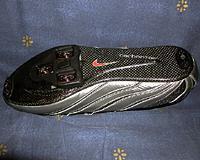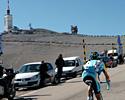
Recently on Cyclingnews.com |
Reviews
Nike Poggio II
Stiff, comfortable and distinctive
By Simon Hayes

|
I remember when I first found out that Nike made cycling shoes. I was in need of a new pair and someone told me that their factory shop was having a sale and that bike shoes could be had for ridiculously low prices. There was an entire wall of bike shoes and they were all being sold for 10-20 percent of normal retail. At that time, as far as I was concerned, Nike didn't have that great a reputation in the sporting world, so I ignored the chance to get a lifetime supply of bike shoes for the cost of one regular pair and walked out of the shop with just two. It's a decision I've regretted ever since because those two pairs lasted me for four years of pretty frequent riding. If I'd spent a bit more I would never have had to buy another bike shoe.
A few years after that, I read Lance Armstrong's autobiography, 'It's not about the bike' and in it he mentions that Nike was one of two sponsors that stood by him when he contracted cancer. He stated that he would be a Nike wearer for the rest of his career and so far has remained true to his word. All of this made me see Nike in a bit of a new light and it was with some pleasure and a great deal of anticipation that I unpacked the 2003 Poggio II road shoes.
The New Poggio II follows on from the 2002 Poggio pro road shoe which was Nike's lightest ever road shoe, weighing in at a mere 260g (size 43) without cleats. The new shoe is ever so slightly heavier at 275g and is also hand made in Italy on Nike's cycling last. It features a carbon sole for maximum power to the pedal, a sock-style inner mesh for comfort and holds your foot with three easily adjustable velcro straps. The Poggio II is available in silver, red or white.
But what is it really like?

|
Well, firstly, if you purchase the silver ones you may want to invest in a good pair of sunglasses before you open the box. These shoes are very bright and like a lot of recent road shoes, look silly unless you happen to be riding in them. They are so glam that when I put them on I didn't know whether to ride or moonwalk in them. Think Michael Jackson, think Slade, think Ace Frehley. There are some people who will think they are the ugliest of bike shoes and others who think they look just great. Interestingly, a quick show of them round the office found that all the people of Mediterranean descent thought they looked great and all the single white male jocks thought they looked ugly. Personally, I thought they looked okay and have grown to like the style the longer I've been wearing them. Like all road shoes, and most bike clothing for that matter, they look much better when you're actually riding a bike.
When you're on the bike and shod in the Poggios, they are really, really comfortable. You hardly notice that you've got them on. There's another shoe manufacturer that likens its bike shoes to your favorite bunny slippers and that comparison could easily be made to these shoes as well. Italian made shoes can tend to be a bit narrow, but while I wouldn't call these a wide fit, they certainly weren't unduly tight around my double E Australian feet. Riders with extra wide feet might like to have a look at Nike's Ventoux Wide road shoes.
The Nike official literature says: "Non stretch mesh seamlessly surrounds the foot with cool breathability." No arguments there. The material used for the liner is very soft to the touch and there was no rubbing or hot spots. The mesh on the upper part of the shoe lets a lot of air in between the straps. This is extremely noticeable, so much so in fact, that booties are mandatory during winter. In hot weather riding however, the breeze does a good job of keeping your feet cool and you hardly notice you're wearing shoes at all. This is a big plus compared to your standard leather and plastic road shoes which can very soon become uncomfortable when the mercury rises.
Nike also says "Newly designed heel counter is larger and more supportive for better heel fit." I can see exactly what they mean here. The upper part of the heel sits in at an angle towards the Achilles tendon and away from the base of the heel. It is a much steeper angle than most shoes on the market. I found that my heel tended to slip when walking in these shoes but there was no sensation of movement during pedaling. In fact, there was no sensation of slip at all when on the bike. Given that walking isn't their intended use, it really shouldn't be a problem. Some people may find it annoying but it wasn't for me.

|
As mentioned earlier, the Nike Poggio 2 has three velcro straps across the upper to hold your foot secure. These have advantages and disadvantages. They're completely stiff and stretch-free, so they hold you firmly in place on the upstroke, and being velcro, they are very quick and easy to adjust, so you can loosen them if your feet swell as you warm up, or as Cyclingnews editor john Stevenson says always happens to him, you can snug them properly if you fail to tighten them enough at the beginning of the ride. However, I was a tiny bit disappointed that the straps don't exactly close down in line with the rest of the patterns on the shoe, and stick up a bit at the fold, rather than lying flat against the upper. This is a very minor aesthetic gripe, but it's an untidy note in an otherwise very striking-looking shoe.
On the road
It's on the bike however that these shoes really stand out. Sole stiffness is a vital feature of a shoe and the Poggios, like so many carbon-soled shoes, have buckets of it. No effort is wasted flexing the sole - 100 percent of your work goes to the pedals. That said, there's a school of thought that says a sole should have some give, especially on longer rides. The idea is that a shoe with some flex will be more comfortable in the long run. However, I found that the Poggio II's stiffness was a comfort in itself - if the sole and footbed fits you properly, then it's comfortable, and stiffness is only a bonus.

|
The stiffness of the carbon sole becomes most apparent when climbing. It's amazing how much easier ascents feel with very stiff shoes. Every pedal stroke seems to make the bike leap forward. On the flat as the cadence goes up, the extra power transfer will give you the chance to pull away from other riders or if you're like me, prevent you from getting dropped off the pack. And yes, I know the actual power loss between a shoe like the Poggio II and something slightly more flexible is microscopic, and that these effects are mostly psychological, but any sports psychologist will tell you that if you feel fast, you usually are!
One group of riders that will probably not get on with the Poggio IIs is triathletes. In the transition between swimming and riding a triathlete wants as little fuss as possible getting into his or her shoes. The sock-like inner tends to scrunch a little as you slide your foot in. Normally this isn't a big deal; you just reach in and smooth it out, but if you are in a tri-transition hurry and your shoes are already in your pedals, it's frustrating.
That aside, this is a fine pair of shoes. Whether you're a serious racer or a weekend warrior upgrading to a pair of Poggio IIs would be a great investment. They're stiff, comfortable and their striking looks will turn heads everywhere you go. I definitely recommend them.
Recommended retail price: $US220.00
Weight: 550g/pr (size 44)
Colours: Red/black; white/black
Pro: Very stiff, very comfortable, striking looks.
Con: Untidy straps, not great for triathlon
Cyclingnews Rating: ![]()
More information: Nike
Cycling's website

